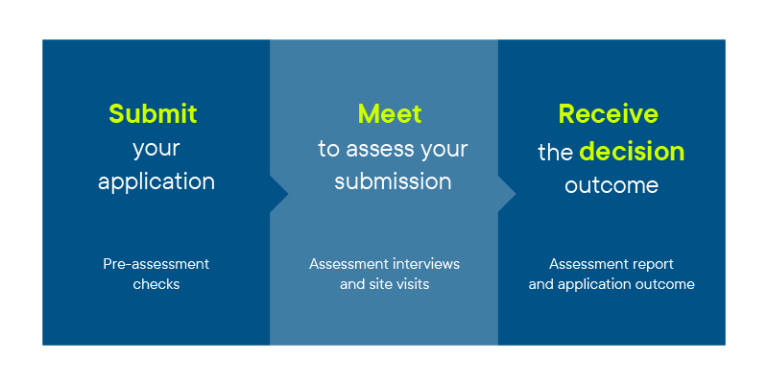- Home
- ESOS providers
- How to become an ESOS or ELICOS provider
- How we assess initial ESOS and ELICOS registration applications
How we assess initial ESOS and ELICOS registration applications
We apply a rigorous risk-based assessment methodology to assess initial registration applications.
We assess initial applications to determine:
- preparedness to be fully compliant with the ESOS Framework from the date of registration
- commitment and capability to maintain compliance in a sustained way over time.
The assessment process
The assessment process is used to gather and assess application information and covers the three key features shown below.

Pre-assessment checks
Before your application is accepted and referred for assessment, we conduct pre-assessment checks to ensure that your application is valid and complete, with all the required information and evidence.
If your application is incomplete, we will let you know, and you will be given 5 calendar days to provide missing information or evidence. If you do not provide the requested documents within the specified timeframe your application will be invalid and will be withdrawn.
Meet your assessor
Your application will be assigned to an assessor once the assessment fee has been received in full.
Once assigned, your assessor will contact you to explain the assessment process and book in key dates for your assessment.
Opening meeting
The opening meeting takes place after your assessor has familiarised themselves with details in your application.
At this stage the assessor will identify and request any additional information or evidence they require to conduct the assessment, and you will be given 5 calendar days to respond with the requested documents.
ASQA’s management of your application reflects the guiding principle that applying for registration as an ESOS provider is voluntary. That means the obligation is on you as the applicant to provide ASQA with accurate and complete information it needs to properly assess the application against the regulatory requirements. It also means quickly responding to ASQA’s requests about your application, including all requests for further information.
Assessment interviews and site visits
Once you provide the information and evidence requested during the opening meeting, your assessor will conduct a thorough assessment of all the evidence you have provided against the ESOS Framework. This will be followed by interviews with you and may involve other key people involved in your organisation.
All applicants will be interviewed and, depending on the nature of your application, you may be required to participate in more than one interview. During interviews your commitment and capability for providing quality education and training will be evaluated by our assessors to inform risk assessment of your application. Depending on the scope and circumstances of your application, ASQA may also undertake a site visit.
Applicant participation
Interviews and site visits may be conducted either in person, or via teleconferencing. Applicants are expected to be available and participate in all requested interviews and site visits during the assessment period.
During interviews and site visits assessors will ask a range of questions to:
- deepen their understanding of how your organisation intends to operate
- clarify information and evidence you have provided
- explore your organisation’s ability to be compliant with the relevant regulatory and legislative requirements.
They may also request that you demonstrate access to locations, facilities and equipment either in- person or via video link.
Demonstrating knowledge of requirements
Applicants will be expected to demonstrate that the organisation will be effectively managed by people who have sufficient knowledge of the requirements of the National Code of Practice for Providers of Education and Training to Overseas Students 2018 (the National Code), and if applicable the English Language Intensive Courses for Overseas Students (ELICOS) Standards 2018 (ELICOS Standards) and the Standards for RTOs 2015 so that they may maintain ongoing compliance. Where owners of the organisation do not have this knowledge, it is expected that the organisation will engage people who do on an ongoing basis.
Closing meeting
Once the assessment interviews are complete and the assessor has considered all the information and evidence in your application, they will finalise the assessment outcomes and arrange a closing meeting with you. During the closing meeting you will be informed of the assessment outcomes, including any issues which were identified during the assessment process.
If there are risks associated with your application, you may be offered an opportunity to respond prior to the closing meeting. This will require you to take action to address the risks and submit evidence of having done so within a specified timeframe. Where there are significant or complex areas of noncompliance, opportunities to respond are unlikely to be extended.
After the closing meeting, your assessor will prepare your initial registration assessment report and make recommendations to the decision maker about whether your application should be granted.
Previous pages
- How we assess initial ESOS and ELICOS registration applications
- Submit your initial ESOS or ELICOS application
- Prepare your initial ESOS or ELICOS application
- How to become an ESOS or ELICOS provider
Related links
Share
